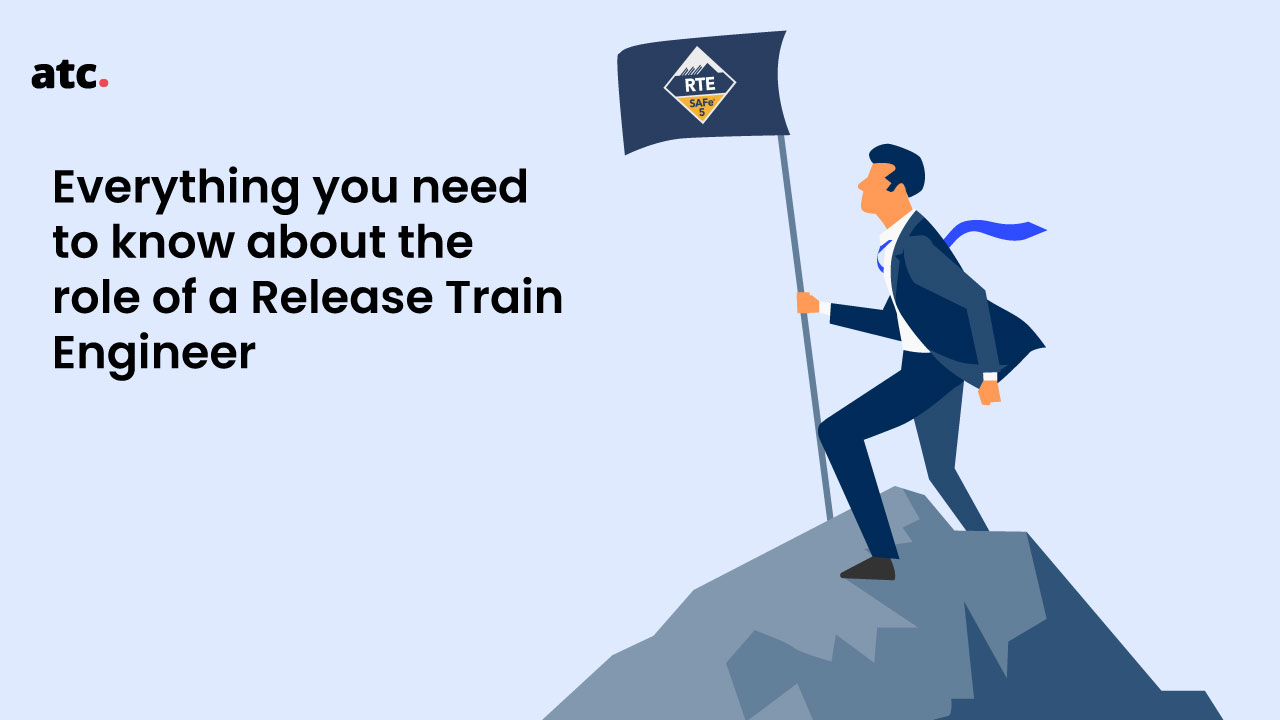Subscribe to the blog
Have you ever wondered how successful tech companies manage to deliver so much so fast? It has nothing to do with luck, that’s for sure.
The secret is simple: They break down complex projects into smaller and achievable tasks and find new and innovative ways for continuous improvement.
But to do that, you have to improve your organizational structure first. And this is where Release Train Engineers (RTEs) come into play. They help facilitate the Agile Release Train (ART) events and processes and manage risks to ensure that the company can continuously improve and deliver.
If you are new to the software development world, this may sound complex. So to ensure that you understand the nuances of a Release Train Engineer’s role, we have broken down every critical component to help you gain clarity. Let’s start with the basics first.
What is Agile Release Train (ART)?
The foundation of a Release Train Engineer’s role starts with facilitating ART. So it is critical to know what an ART is first.
In a nutshell, ART is a long-standing team comprising several Agile teams with all key stakeholders who plan, execute, test, deploy and ensure the release of the software. Typically ART consists of 70 to 125 people, but it changes as per the project needs. They work together with a common goal and follow SAFe practices and principles to complete large projects faster and more efficiently.
How do Release Train Engineers fit here?
Although ART is autonomous and collaborative, they have fixed deadlines that they need to follow. And since most projects are complicated, there may be several risk factors that may impede the progress.
The role of a Release Train Engineer is to ensure that the ART team works well together and there are no impediments. They facilitate every ART event and process and apply SAFe principles to ensure maximum value delivery.
Top RTE roles and responsibilities!
Let’s move on to top RTE roles and responsibilities.
- Program Increment (PI) planning and execution
A technical aspect of an RTE’s role involves Program Increment (PI) planning and execution. PI planning is a time-boxed event where ART meets and estimates what deliverables will be achieved in a particular cycle and its dependencies. On the other hand, PI execution is a loop of events that includes following systems to keep the trains on track.
As the facilitator of ART, an RTE takes an active part in PI planning and execution and does the following:
- PI objectives: The RTE must work with multiple stakeholders on creating a backlog of features and should communicate it to the team. They must also assist the team in feature estimation and drive the product vision. They also facilitate the PI planning events.
- PI planning outputs: They must log all the ART goals, risks, and dependencies. It encourages visibility and transparency across all teams.
- Scrums of Scrums: RTE invites other Scrum Masters, Quality Assurance managers, and specialists to discuss the ongoing progress and how to improve the process. They assist in tracking the information related to the execution of features and capabilities.
- Inspect and adapt: The RTE must facilitate the inspect and adapt event that usually happens at the end of the PI cycle. ART discusses and gathers feedback about the current project and how to improve the process. The RTE must log all the information and provide input about removing the bottlenecks.
Besides the above events, the RTE also explores metrics to measure PI execution and examine the value streaming map to identify opportunities. The role of an RTE differs from company to company based on the goal of the ART.
- Coach ART and facilitate collaboration
RTE's roles and responsibilities include coaching ART on improving efficiency and boosting collaboration to ensure strategy and execution alignment. They apply a combination of lean and SAFe practices into the workflow for continuous delivery.
Here’s how an RTE becomes a servant leader:
- They facilitate periodic synchronization events, including the ART sync, so that the team is on the same page and vital information is communicated.
- A vital responsibility of an RTE is to maintain positive employee and team experiences. It includes assessing the current situation and finding ways to drive the team toward success through healthy discussions and communication. It is also critical to listen to the team, address their needs and create a culture with trust and flexibility.
- There is also a need for RTEs to create roadmaps to help the team stay on track and understand what comes next.
- Risk elimination
With a team having 100 members, things will be challenging. As the ART driver, you are in charge of making things as smooth as possible. It includes having oversight of all the activities, subsequent reporting, analyzing, and risk elimination.
Let’s discuss an RTE’s roles and responsibilities on how they eliminate risk and keep the value flow smooth:
- Having an economic view: Besides being a servant leader, an RTE must have a practical understanding of the team's choices. They must operate with Lean budgets and ensure adherence to guardrails. This ensures that there are no budget crunches or wastages and that each unit has enough resources.
- Addressing surface risks: Using project management tools such as the Kanban board, RTE helps minimize surface risks.
- Resolves conflicts: As stated above, RTE must communicate with every stakeholder to eliminate underlying concerns.
- Keeping an eye out for potential hazards: It is imperative to eliminate potential hazards before they disrupt growth and keep others in the loop to figure out possible solutions.
Career scope of a Release Train Engineer
If you are thinking of becoming a Release Train Engineer, it is critical to know their career scope:
Apart from software development, the demand for RTE is bound to increase across industries, such as cybersecurity, fintech, defense, retail, and manufacturing.
It is also critical to note the average salary of an RTE can vary depending on their skills, experience, and knowledge. This is why it makes sense to ace your Release Train Engineer examination and include the practical experience to make your resume stand out to potential employers.
Top Skills you need to have to become a Release Train Engineer!
Every prospective RTE must possess the following skillset to become successful at their workplace.
Technical skills
- Have a working knowledge of the SAFe framework and Lean principles. Since RTE works in a SAFe enterprise, they must adhere to agile-lean practices and coach others about them.
- Understand the art of organizing ART. Also, knowing how to plan and execute PI. It includes considering the practical aspects, methodologies, and processes.
- Using other project management tools and frameworks, such as Kanban and Scrum is a must.
- Knowing how to do budgeting and use forecasting techniques. Using metrics and analytical tools for proper reporting.
Personal skills
- Coach and teach teams about lean and agile management techniques. And nurturing group dynamics to create a one-team culture.
- Beyond day-to-day tasks, they must think of newer ways to encourage each team member to perform their best. Also, have an Agile mindset to ensure the framework is applied thoroughly.
- Must be a continuous learner and commit to business goals. Since the software development industry constantly evolves, the complexity of projects will also increase. So having the curiosity to learn industry trends is a must.
- Have excellent communication skills and must be able to collaborate with others. Being a team player is the key.
Gain the skill set to become an RTE with ATC!
Getting RTE-certified opens a pathway to one of the most coveted jobs in the technology industry. And we are here to set you up for success.
Our RTE training course will be led by Dr. Thomas Baxter, a seasoned and accomplished senior IT leader with over 25 years of experience. This course will give you practical insights into current industry trends and technologies.
The 3-Day training program equips attendees with the knowledge to apply Agile Release Trains (ARTs) to enable end-to-end delivery.
Highlights of our RTE training program:
- Get trained by experienced industry experts to grasp solid concepts and tackle challenges while aligning large development projects and scaling lean practices.
- Learn to facilitate PI Planning, foster Continuous Exploration, and execute other SAFe events successfully.
- Understand the concepts, tools, and resources you need to release value for continual improvement.
Also, if you register now, you get an exclusive discount of $700. So book your spot here today!




